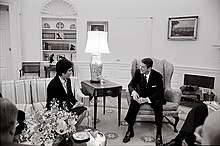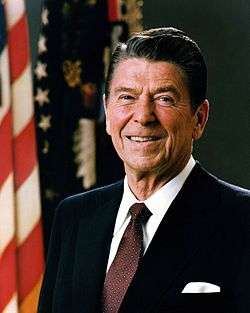Anne Gorsuch Burford
| Anne Gorsuch Burford | |
|---|---|
 | |
| 4th Administrator of the Environmental Protection Agency | |
|
In office May 5, 1981 – March 9, 1983 | |
| President | Ronald Reagan |
| Deputy | John Hernandez |
| Preceded by | Douglas Costle |
| Succeeded by | William Ruckelshaus |
| Member of the Colorado House of Representatives from the 12th district | |
|
In office 1976–1980 | |
| Preceded by | David Gaon |
| Succeeded by | Don Eberle |
| Personal details | |
| Born |
Anne Irene McGill April 21, 1942 Casper, Wyoming, U.S. |
| Died |
July 18, 2004 (aged 62) Aurora, Colorado, U.S. |
| Political party | Republican |
| Spouse(s) |
David Gorsuch (m. 1964; div. 1982) |
| Children | 3, including Neil |
| Education | University of Colorado Boulder (BA, JD) |
Anne Irene McGill Gorsuch Burford (April 21, 1942 – July 18, 2004), also known as Anne M. Gorsuch (/ˈɡɔːrsətʃ/), was an American attorney and politician. Between 1981 and 1983, while known as Anne M. Gorsuch, she served under President Ronald Reagan as the first female Administrator of the Environmental Protection Agency (EPA). She was the mother of current Associate Justice of the Supreme Court Neil Gorsuch.
Early life and education
Born Anne Irene McGill in Casper, Wyoming, she was one of seven children of Joseph John McGill II,[1] a surgeon, and Dorothy Jean (née O'Grady). She grew up in Denver, where she attended St. Francis DeSales High School.[2]
During three consecutive summers, she took classes in Spanish at the National University of Mexico.[3] She studied at the University of Colorado at Boulder, earning a Bachelor of Arts degree in 1961 at the age of 19. She then attended the University of Colorado Law School where she received a Juris Doctor degree in 1964 at the age of 22.[3][4] McGill participated in the undergraduate Honors Program and Mortar Board society, and was an editor of the University of Colorado Law School's law review.[3] She was awarded a Fulbright Scholarship to study criminal law for one year in Jaipur, India,[3] and she and her new husband David Gorsuch travelled there together.
Early legal and political career
Gorsuch was first employed as an attorney with a bank trust department, then as an assistant district attorney for Jefferson County, Colorado, and as deputy district attorney for the City of Denver, Colorado.[2] Subsequently she was a corporate attorney for Mountain Bell Telephone.[2] In 1975 she was elected to the Colorado House of Representatives, and served in office for two two-year terms. She was voted Outstanding Freshman Legislator, but was considered by some to be a member of the "House Crazies," a group of "conservative lawmakers intent on permanently changing government."[3][4][2]
In 1980, Gorsuch served on President-elect Reagan's transition team as a member of his Advisory Committee on Intergovernmental Relations.[3] Shortly after Reagan was inaugurated, Gorsuch was nominated as administrator of the EPA. The nomination was unanimously confirmed by the Senate three months later on May 5, 1981.[5]
EPA Administrator

Gorsuch based her administration of the EPA on the New Federalism approach of downsizing federal agencies by delegating their functions and services to the individual states.[6] She believed that the EPA was over-regulating business and that the agency was too large and not cost-effective. During her 22 months as agency head, she cut the budget of the EPA by 22%, reduced the number of cases filed against polluters, relaxed Clean Air Act regulations, and facilitated the spraying of restricted-use pesticides. She cut the total number of agency employees, and hired staff from the industries they were supposed to be regulating.[4] Environmentalists contended that her policies were designed to placate polluters, and accused her of trying to dismantle the agency.[2]
Thriftway Company
Thriftway Company, a small oil refinery in Farmington, New Mexico, asked Gorsuch for a meeting to discuss the regulations limiting lead content of gasoline, the program under Section 211 of the Clean Air Act designed to reduce the amount of lead in gasoline in annual phases, and to receive relief from the standard.[7] In December 1981, while EPA was developing revisions to those regulation at the request of the Reagan Administration, Gorsuch met with representatives from the company, who asked her to excuse Thriftway from compliance with the lead limits because "the company faced financial ruin if it could not obtain quick relief from the regulations". Gorsuch did not commit herself in writing but she did tell them they could count on her promise as the word of the EPA Administrator that she would not enforce the regulations.[7]
Superfund
In 1982, Congress charged that the EPA had mishandled the $1.6 billion toxic waste Superfund and demanded records from Gorsuch. Gorsuch refused and became the first agency director in U.S. history to be cited for contempt of Congress.[8] The EPA turned the documents over to Congress several months later, after the White House abandoned its court claim that the documents could not be subpoenaed by Congress because they were covered by executive privilege. At that point, Gorsuch resigned her post, citing pressures caused by the media and the congressional investigation.[9]
EPA legacy
Looking back at her tenure several years later, Gorsuch expressed pride in the downsizing done under her watch and frustration at the program backlogs and lack of staff management skills that she encountered while at the helm of the agency.[6] She said there was a conflict between what she was required to do under a "set of commands from Congress," and what her own priorities were, although she felt that by the end of her administration, she had developed a way of resolving those conflicts. In her retrospective, Gorsuch admitted that she and her staff "were so bogged down in the fight with Congress over the doctrine of executive privilege, that the agency itself seemed hardly to be functioning," but claimed that despite appearances the agency still functioned.[6] Analysts have argued that she was given a difficult job by the Reagan Administration, but she was not provided the support she needed, leading to her early departure from her director position at the EPA.[10]
Subsequent career
Gorsuch was promised another job by Reagan, and in July 1984, he appointed her to a three-year term as chair of the National Advisory Committee on Oceans and Atmosphere, a move that was criticized by environmental groups.[11] She described the post as a "nothing-burger", and both the House and the Senate passed non-binding resolutions calling on President Reagan to withdraw the appointment. Ultimately, Gorsuch chose not to accept the position.[12]
After leaving government service, she wrote a 1986 book about her experiences entitled Are You Tough Enough?[13] She then worked as a private attorney in Colorado until her death.[2] According to her son, Neil Gorsuch, she spent a significant amount of her time after the EPA work pursuing "deadbeat dads", long before that term was popular.[2]
Personal life
Anne McGill married David Gorsuch after finishing law school. They divorced in 1982 while she was serving as EPA Administrator. The couple had two sons, J. J. and Neil, and a daughter, Stephanie.[4] Neil Gorsuch is an Associate Justice of the United States Supreme Court.[14]
In 1983, Gorsuch married Bureau of Land Management head and rancher Robert F. Burford, with whom she had previously served in the Colorado House of Representatives. A divorce from Burford was pending when he died in 1993.[2]
Gorsuch died from cancer in 2004 in Aurora, Colorado, aged 62.[15]
References
- ↑ "Dr. Joseph John McGill, II". geni.com.
- 1 2 3 4 5 6 7 8 Martin, Douglas (July 22, 2004). "Anne Gorsuch Burford, 62, Reagan E.P.A. Chief, Dies". The New York Times. New York City, New York. Retrieved February 1, 2017.
- 1 2 3 4 5 6 Anne M. Gorsuch (Burford) profile at EPA website
- 1 2 3 4 Sullivan, Patricia. "Anne Gorsuch Burford, 62, Dies; Reagan EPA Director", The Washington Post, July 22, 2004; p. B06.
- ↑ "Nomination of Ann McGill Gorsuch To Be Administrator of the Environmental Protection Agency", February 21, 1981.
- 1 2 3 "Views from the Former Administrators". EPA Journal. November 1985. Archived from the original on 2002-06-20.
- 1 2 Shabecoff, Philip (April 13, 1982). "E.P.A. Chief Assailed on Lead Violation". The New York Times. New York. Retrieved February 1, 2017.
- ↑ "House Charges Head of E.P.A. With Contempt". The New York Times. 17 December 1982.
- ↑ "Burford Resigns As Administrator of Embattled EPA", Toledo Blade, Mar 10, 1983, p. 1
- ↑ Pratt, Lawrence D.; Olsen, William J. (January 30, 2017). "Judge Neil Gorsuch: Some Cause for Concern". American Thinker. El Cerrito, California. Retrieved January 30, 2017.
- ↑ "Washington: Bad Choice, Worse Timing", Time, July 16, 1984.
- ↑ "Posturing, Not Legislating", Time, Aug. 13, 1984.
- ↑ Burford, Anne and Greenya, John. Are You Tough Enough?, McGraw-Hill, February 1986.
- ↑ "Neil Gorsuch: Donald Trump's nominee is sworn in as next Supreme Court justice despite Democrat opposition".
- ↑ "Neil Gorsuch revives his mother's political legacy in Colorado".
External links
| Political offices | ||
|---|---|---|
| Preceded by Douglas Costle |
Administrator of the Environmental Protection Agency 1981–1983 |
Succeeded by William Ruckelshaus |
